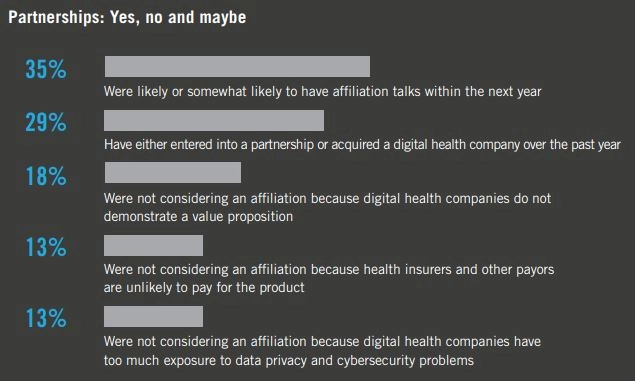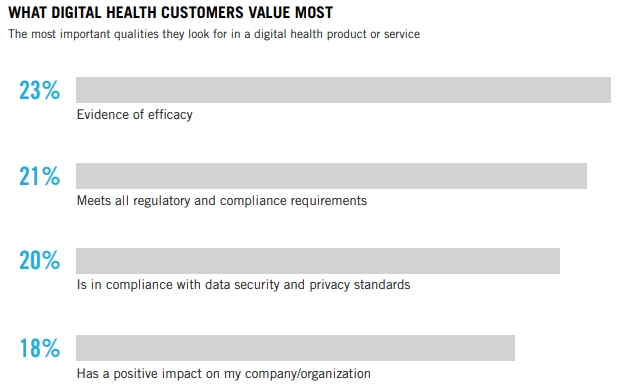

How to Dispel Stakeholders’ Doubts About Your Digital Health Product
The healthcare industry is a complicated field to choose when founding a startup. Quiet obvious why: potential direct impact on people’s health, privacy issues throughout the whole domain, long sales cycles, and regulations have to be considered — and it is quite hard to. Success is extremely rewarding, though, and can radically improve care outcomes and cost of operations.
Working with digital health startups, we learned a lot both about them — and about their future clients, healthcare stakeholders: providers, pharma companies, and other life science businesses.
Despite the fact that each week — as we observe, preparing for filming our digest — some success stories on a partnership between a digital health tech company and some private clinic, hospital, or lab appears, almost half of healthcare stakeholders don’t plan to pursue digital tech or formulate a new collaboration.
Why is that and what startups can do to fix that?
Why healthcare stakeholders are not convinced your product will be good for them
Digital health operates on the intersection of two different cultures.
It’s a tech culture of Silicon Valley and startups all over the world that dictates startupers to move fast and break things. It’s a culture of science and rationality that urges them to obtain proves their product will really be efficient and useful for stakeholders and, therefore, for patients.
You don’t have a clear value proposition
According to Ropes & Gray law firm recent report that surveyed 300 healthcare stakeholders from different branches of the industry, the main reason they refuse to partner with digital health companies is that the latter “don’t demonstrate value proposition.”

Don’t get us wrong, any industry you’ll be planning to enter on the Shiny New Technology horse will challenge the value of your product.
Healthcare, though, for better or for worse will have much less desire to try your thing if your value proposition doesn’t have bullet-proof clarity, clinical evidence.
The memory of Theranos is still very fresh.
Among from the obvious patient care side of the deal, the healthcare industry (at least in the USA) has a complex way of paying for new tech in its ecosystem, so it’s only understandable that they don’t want to try.
They want it to work and payoff.
They think no one will pay for your product
The money question is the second part of why stakeholders don’t plan on going for it within digital healthcare.
Who is going to finance the purchase of your product and its adoption? Is the product beneficial and reliable enough for insurers and payers to pay for it?
Did you clearly demonstrate that pursuing a consumer-facing technology’s value will, eventually, bring the organization more profits than seeing people in person?
Because hospital visits are bread of healthcare. You may dwell on the cynicality of it: not wanting to immediately integrate something that will help patients — but, in the cruel capitalist world, money, salaries, profits are what stakeholders care about.
Surely, due to the absence of insurance coverage, it gets ridiculous and dangerous in the USA, but it’s the reality you’ve got to operate in. We’ll elaborate on how to address the need in the next section.
They are worried about the security of your product
Finally, the third reason is about cybersecurity. As you probably know, the healthcare industry pays more than any other domain for cyberattacks. Its legacy systems, combined with a lack of employee training is a perfect cookie for criminals to snatch patient data out of hospitals, research organizations, etc.
So, what do you do to shift the mind of your stakeholders from rejection due to doubts about joining, for instance, the other half that wants to have an affiliation? Let’s see.
1. Understand the market. In a nerdy way
Tech, by definition, can’t be a remedy for all ills. You need to find out how it can be adopted and used in an organization you’re trying to convince, how it will affect its operations, its position on the market. When will competitive advantage you promise will be reached? How much money is needed for transformation?
Keep in mind, that there’s no “secret plothole” in stakeholders’ defensiveness about digital health products. Making a decision, they need to reach an agreement, and you need to understand that
- They often don’t have needed knowledge about nice features you’re talking about, so being not able to make a truly well-informed choice, they prefer not to choose you at all.
- Provider organizations often don’t have a digital health adoption strategy. Working with siloed systems, they need to know if your product can integrate well with all parts of Frankenstein.
In such a way, you have to come down on the imaginary hierarchic stairway, to figure out what challenges administrators, doctors, researchers in an organization face — and what reasons may it be for them to postpone or embrace digital adoption?
Nurses suffer from alarm fatigue. Doctors spend so much time in front of a computer that it eats up the major piece of their patient-interaction time.
Finally, talk to patients of the targeted organization. Connect their needs to what your product may help accomplish. Patients want to make appointments online. They want to freely access their clinical data. They don’t want to do a repeat lab tests.
Summarize the info about market and challenges in it. Ensure you have no blank spots in the chain of reasoning.
2. Run clinical trials and user research
Startupers want to bring their product to market faster.
Obviously, the requirement to have clinical evidence of its efficiency isn’t streamlining things.
But, in the healthcare sector, you can’t do a mass release and fix and iterate afterwards.
Doing clinical trial before going onto the market is going to give you:
- Stakeholders’ sympathy: someone has finally spoken in a risk aversion language! Believe us, in the world of thousand apps that claim to cure depression in three user logins, homeopathy, vaccine-cause-autism discourse and other delightful and misleading things that pop up in the forever sleep-deprived healthcare sector, clinical evidence is a sight for sore eyes.
- An open path for FDA approval, which is a huge deal for stakeholders.
- Confidence! We know most founders of tech companies are confident in their product, but let’s agree that confidence, that roots in evidence, is much more reliable than the one that doesn’t.
You can check our article on user research to have more clear picture of the process (which is not clinical trials but still can be useful if your product has administrative or operational focus.)

3. Comply with regulations
Tech companies have opinions that regulations like FDA and HIPAA stay in the way of innovation.
First of all, that’s not the case. Regulators operate on the rules of risk assessments and benefits for public health, and it’s normal and beneficial for patients and providers to use a product that is secure.
Second of all, if they use products that are not compliant, they’re paying crazy money for violation of regulations.
So, clinical trials and HIPAA recommendations on data and privacy security are a must if you want to win stakeholders’ trust. Encryption, all that.
Read our articles on how to comply with HIPAA regulations: Physical, Administrative Safeguards and Breach Notification Rule; Technical Safeguards; HIPAA employee training; HIPAA for Apps and wearables; and another, more throughout take on why your startup really needs compliance.
4. Mind the data
Don’t forget to document what you are going to do with patients’ data if you want to enter a Business Associate Agreement: put an agreement in clear, concise language and describe the operations with data as fully as possible.
A lot of stakeholders aren’t crazy about collaborating with, e.g. AI and data science companies because there is no clarity on whether or not they’re familiar with all the risky aspects of data transactions and other operations, so make sure to express your expertise in that.
A question of intellectual property also pops up when working with patients’ or operational data, so thoroughly elaborate on how data will be stored, processed, and used, commercially and non-commercially.
It’s better to validate your data security strategy with some penetration test visualisations. It’s explanatory (and entertaining) evidence of a good protection quality.
Also, if you’re working on patient-facing applications, ensure you have an explicit request for patients’ consent on storing and processing their specific data. If you’re gathering data from EHR, prepare a document for providers to use when getting consent from patients. We recommend doing it even if you’re going to de-identify the data.
5. Measure the efficiency of your product
As we’ve already mentioned there’s no lack of case studies in digital health companies.
For instance, this week, Sentara, one of the oldest health systems in America implemented a biometric technology that will help to identify all of their patients — even those who can’t talk.
Or mobile breath sensor device from Carrot helped 32% of smokers (from their clinical study) to quit.
That’s huge.
To measure the benefits of your product adoption, you need to use your notes on market research and run a test study (or use figures from clinical trials).
If it’s a solution for doctors, ask them to work with your system. See how much time it takes to fill the patients’ profile.
If it’s a solution for nurses, calculate how much time they will save if they go to patients who really need their attention. How it will impact productivity.
You’ve got the idea. Test your product and compare the numbers you’ll have with industry’s average or with an organization’s average — it’s better. You can figure these numbers out by… going to physicians, for example, and asking them for advice.
By the way, including healthcare workers in your R&D process will drastically add up to your credibility. They will help you find blind spots in the industry knowledge, gather patients for clinical trials, iterate your product before going to stakeholders.
Plus, they may help you to get into an organization. It’s always good to have people on your side.
Clear measurements allow you to tackle stakeholders’ profitability doubts.
Final words on bits of digital healthcare marketing
Another trait of startup culture is to invest in marketing when things are not as good as they expected.
While this trend decreases with years, we still want to address the following: if you want to improve public health, you may also want to appear in public spaces while growing your thing from idea to deals.
You’ll find supporters in the patient advocacy community (especially if you work with their data!), gain PR traction if you share the results of your user testing (no identifiable patient info, though). That will help you to spread the news about your clinical achievements and, therefore, will shift the odds in your favour in stakeholders.
If you want our powerful engineers to help you build your digital health product and our strategists to help you figure out what tech to use and how to approach market research, contact us!
Tell us about your project
Fill out the form or contact us

Tell us about your project
Thank you
Your submission is received and we will contact you soon
Follow us
